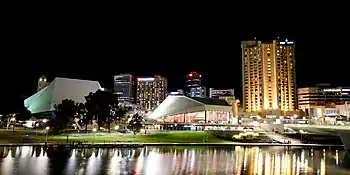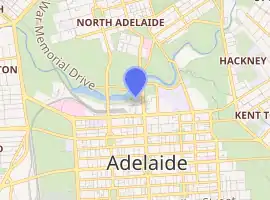Adelaide Festival Centre
Adelaide Festival Centre, Australia's first multi-purpose arts centre and the home of South Australia's performing arts, was built in the 1970s. The Festival Theatre opened in June 1973 with the rest of the centre following soon afterwards. The complex includes Festival Theatre, Dunstan Playhouse, Space Theatre (formerly The Space) and several gallery and function spaces. Located approximately 50 metres (160 ft) north of the corner of North Terrace and King William Road, lying near the banks of the River Torrens and adjacent to Elder Park, it is distinguished by its two white geometric dome roofs, and lies on a 45-degree angle to the city's grid.
 Adelaide Festival Centre at night with the River Torrens in the foreground | |

| |
| Address | King William Road Adelaide, South Australia |
|---|---|
| Coordinates | 34°55′10″S 138°35′52″E |
| Owner | Adelaide Festival Centre Trust |
| Type | Performing arts centre |
| Capacity | Festival Theatre: 2,000 Dunstan Playhouse: 590 Space Theatre: 350 Her Majesty's Theatre: 1,009 |
| Opened | 2 June 1973 |
| Website | |
| www | |
Adelaide Festival Centre hosts Adelaide Festival and presents major festivals across the year including Adelaide Cabaret Festival, OzAsia Festival, DreamBIG Children's Festival, Adelaide Guitar Festival and OUR MOB. It is also home to Adelaide Symphony Orchestra, State Opera South Australia, Australian Dance Theatre, State Theatre Company of South Australia, The Australian Ballet, Brink and Windmill Theatre Co.
The Festival Centre is managed by a statutory corporation, the Adelaide Festival Centre Trust, which is responsible for encouraging and facilitating artistic, cultural and performing arts activities, as well as maintaining and improving the building and facilities of the Adelaide Festival Centre complex and Her Majesty's Theatre.
The Festival Centre was erected on the site of the Adelaide City Baths, which had been there for over a century.
History and construction
Background
In the 1960s, the Adelaide Festival of the Arts started to outgrow the city's existing venues, and there was a push to build a "Festival Hall". The Adelaide Festival Theatre Act 1964 provided for the erection of the Festival Theatre building.[1] The originally proposed site was the Carclew building in North Adelaide, which had been purchased from the Bonython family by the Adelaide City Council for the purposes of building a Festival Hall.[2]
Liberal state Premier Steele Hall lobbied the Federal Government for tax concessions for a public appeal for the Festival Hall, which was initially unsuccessful, until Prime Minister John Gorton offered Hall either tax concessions or A$100,000 . Hall accepted the money.[3] While on a trip to London, Steele Hall visited the Royal Festival Hall on the banks of the River Thames and decided that the banks of the River Torrens was the ideal choice for the site of the Adelaide Festival of the Arts and the cultural heart of the city. During this time, the state government changed hands, but the drive for a new centre continued with fervour. When Don Dunstan became Premier he expanded the idea into a "Festival Centre", incorporating multiple smaller venues.[4]
The Lord Mayor of Adelaide, Robert Porter, supported by Dunstan, launched a public appeal to raise funds to build the Festival Centre and establish Adelaide as a significant city in the art world. The appeal raised its target within a week, and was soon over-subscribed; the surplus was set aside to create a collection of artworks to grace the new building.
The Adelaide City Baths, which had stood on the site since their creation in 1861 and upgraded several times since, including the addition of an Olympic-sized swimming pool in 1940, were demolished in 1969 to make way for the new centre.[5]

(From left-to-right, starting SE):
Background: (SE): Government House, The Myer Centre, (S): Parliament House, Dame Roma Mitchell Building (SW): Adelaide railway station/Casino/Hyatt Hotel
Foreground: (SE): Southern Plaza, (S-to-W) City Sign
Background:(W-to-N): Adelaide Festival Centre: The Dunstan Playhouse, The Space Theatre, The outdoor amphitheatre, The Festival Theatre
Foreground:(W-to-N): Southern Plaza
Background:(N-to-NE): The Festival Theatre (northern) Plaza, (NE-to-E): Trees along King William Road
Foreground:(N-to-E): Stairs from Southern Plaza down to Festival Theatre Plaza, and Southern Plaza.
Construction
Adelaide Festival Centre, Australia's first multi-purpose arts centre, was built in three parts from April 1970 to 1980.[6] It was designed from the inside out by architect John Morphett.
The main building, the Festival Theatre, was completed in 1973, within its budget of $10 million.[6] On 2 June 1973 the Festival Theatre was officially opened by Prime Minister Gough Whitlam at a gala performance of Act Two, Scene 1 of Beethoven's opera Fidelio and Choral Symphony. The construction of the Playhouse (now Dunstan Playhouse), Space Theatre and Amphitheatre followed.
Outdoor sculptures graced the outdoor spaces, including the prominent stainless steel Environmental Sculpture (also known as Tetrahedra), by Bert Flugelman.
South of complex, the Festival Plaza was completed in March 1977, comprising a then-controversial environmental sculpture by West German artist Otto Hajek. The sculpture was conceived as a concrete garden and iconic City Sign. The lego-like forms and colourful paint work across the plaza were designed to conceal an air-conditioning vent at the same time as provide a playful place to congregate. However, Adelaide's citizens never warmed to the idea, the sculpture suffered poor maintenance, and it remained one of Adelaide's most under-utilised public spaces[7] until its demolition in 2018.
The whole Centre was completed for A$21 million . (By comparison, the Sydney Opera House, completed in 1973, cost A$102 million .)[6]
21st century redevelopment
In 2003, the area around Adelaide Festival Centre was redeveloped substantially. The much-maligned Festival Plaza was redesigned, including opening the underground plaza to the sky and building a pedestrian suspension bridge to link the Plaza to the nearby Riverbank Precinct and a few cafés, restaurants and retail outlets.
From 2016 the Festival Plaza has been undergoing a A$90 million redevelopment, as part of the major redevelopment of the Riverbank Precinct, expected to be complete in 2022.[8]
A short branch from the Glenelg tram line to the Festival Centre was opened in October 2018.[9]
Governance
In 1971 the Adelaide Festival Centre Trust was established as a statutory authority by the Adelaide Festival Centre Trust Act 1971, reporting to the Minister for the Arts.[10]
From about 1996 until late 2018, Arts SA (later Arts South Australia) had responsibility for this and several other statutory bodies such as the South Australian Museum and the Art Gallery of South Australia. Arts SA leased Her Majesty's Theatre and the Festival Centre to the Trust, which was responsible for "encouraging and facilitating artistic, cultural and performing arts activities throughout the State" and managing and maintaining the theatres.[11]
In July 2017, the Trust bought Her Majesty's Theatre from Arts South Australia for A$8 million . It also borrowed A$62 million from the South Australian Government Financing Authority for a maximum term of 10 years to fund Her Majesty’s Theatre redevelopment.[8]
From late 2018, the functions previously held by Arts SA were transferred to direct oversight by the Department of the Premier and Cabinet, Arts and Culture section.[12]
Venues
Adelaide Festival Centre houses the several theatres and galleries, as well as function spaces and the administrative hub of the Festival Centre.
- Festival Theatre is the largest proscenium arch theatre in Adelaide, seating close to 2000 people. It was designed as both a lyric theatre and concert hall, and is used not only for theatrical productions and large concerts, but also for graduation ceremonies, seminars and many other community functions. Its huge backstage area makes the stage area one of the largest in the southern hemisphere. It also houses the Silver Jubilee Organ, a "hovering" pipe organ built and donated to mark the Silver Jubilee of Queen Elizabeth II.
- Dunstan Playhouse, located in the Drama Centre behind the main building, is a more intimate venue, seating 620 people on two levels. The State Theatre Company has been based here since 1974, and uses the theatre, the rehearsal rooms and the extensive production workshop also housed in this second building.
- Space Theatre is a versatile studio theatre, sharing the Drama Centre building with the Dunstan. It has no traditional stage or fixed seating, meaning its configuration is completely flexible. It can be turned into a theatre in the round, a corner stage setting, or a cabaret venue. The Space seats anywhere from 200 to 350 people, depending on the configuration.
- Her Majesty's Theatre is a newly redeveloped 1500-seat theatre located on Grote Street. First opened in 1913, the theatre underwent extensive rebuilding from 2018 to 2020 to become a world-class venue.
- Artspace Gallery is a gallery exhibition space situated in the second building above the Dunstan Playhouse.
- The Terrace (formerly called the Amphitheatre) is an outdoor space overlooking Elder Park and the River Torrens.
- Artspace Gallery and QBE Galleries are further exhibition spaces.
Associated companies and events
Adelaide Festival Centre is home to South Australia's leading professional performance companies, including Adelaide Symphony Orchestra, State Opera South Australia, Australian Dance Theatre, State Theatre Company of South Australia, Brink Productions and Windmill Theatre Co.[13]
It is the host of Adelaide Festival and presents major festivals across the year including: Adelaide Cabaret Festival, Adelaide Guitar Festival, OzAsia Festival, DreamBIG Children's Festival and OUR MOB.
References
- "Adelaide Festival Theatre Act 1964" (PDF). Government of South Australia. Attorney-General's Dept. 1 July 1999. Retrieved 31 July 2019. Cite journal requires
|journal=(help) - Morgan, Felicity. , Flinders University, Interview with Marjorie Fitzgerald OAM.
- Campbell, Lance. By Popular Demand: The Adelaide Festival Centre Story, pg 18.
- Llewellyn-Smith, Michael. Behind the Scenes: The Politics of Planning Adelaide, University of Adelaide Press
- "Adelaide City Baths". Adelaidia. Retrieved 31 July 2019.
- Sydney Opera House Archived 18 November 2006 at the Wayback Machine
- Festival Centre Plaza
- "Adelaide Festival Centre Trust (AFCT) (2016-7 Audit)" (PDF). 2017. Retrieved 31 July 2019. Cite journal requires
|journal=(help) - Boisvert, Eugene (13 October 2018). "Trams start running on Adelaide's North Terrace extension seven months late". ABC News. Australian Broadcasting Corporation. Retrieved 14 October 2018.
- "AAdelaide Festival Centre Trust Act 1971" (PDF). Government of South Australia. Attorney-General's Dept. 12 May 2011. Retrieved 31 July 2019. Cite journal requires
|journal=(help) - Auditor-General (2015). "Annual Report for the year ended 30 June 2015: Part B - Agency audit reports" (PDF). Government of South Australia. Retrieved 28 July 2019. Cite journal requires
|journal=(help) - "About arts and culture". South Australia. Dept of the Premier and Cabinet. Retrieved 27 July 2019.
- "Overview". Adelaide Festival Centre. Retrieved 31 July 2019.
Further reading
- Scott, Jenny (2006). "Torrens Lake from the City Bridge" (photograph). SA Memories. Text by SLSA. State Library of South Australia. Features Adelaide Festival Centre and Adelaide Convention Centre, with information about the design and construction of both.